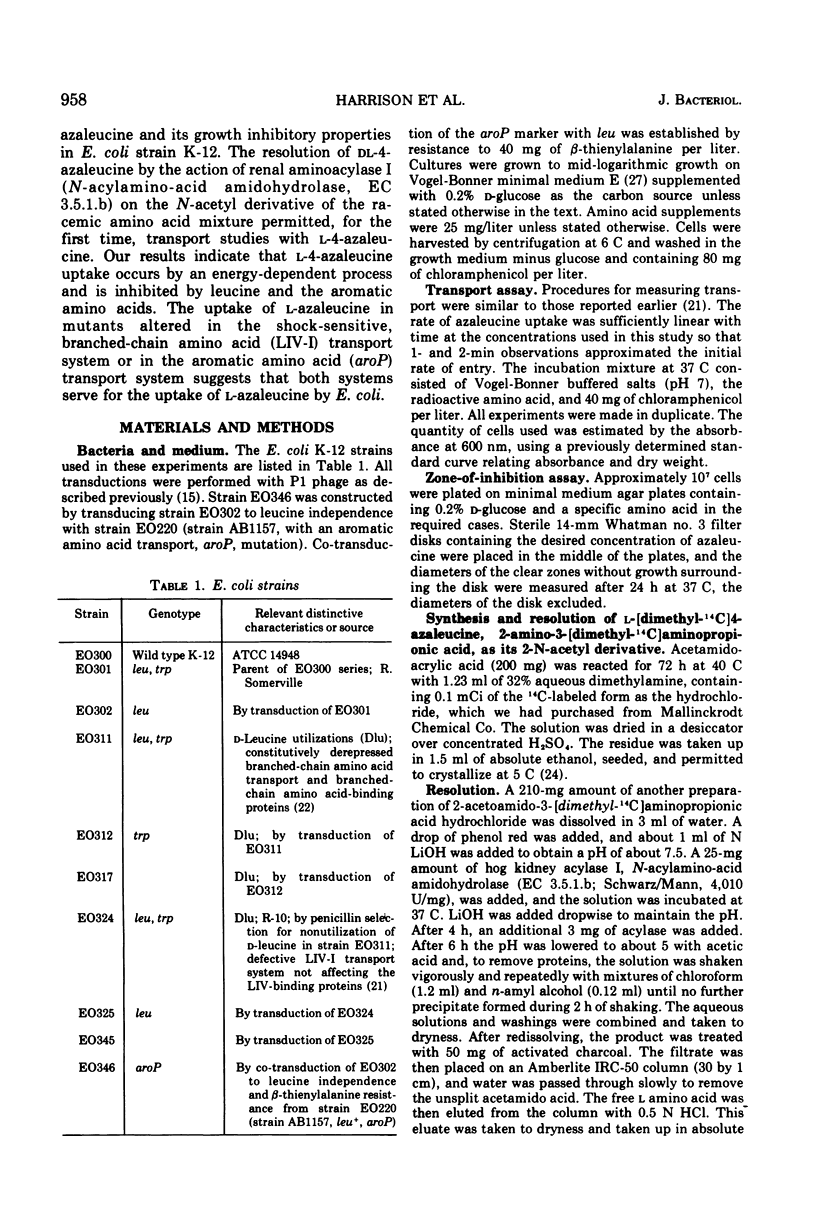Abstract
The uptake of L-4-azaleucine was examined in Escherichia coli K-12 strains to determine the systems that serve for its accumulation. L-4=Azaleucine in radio-labeled form was synthesized and resolved by the action of hog kidney N-acylamino-acid amidohydrolase (EC 3.5.1.B) on the racemic alpha-N-acetyl derivative of DL-[dimethyl-14C]4-azaleucine. L-4-Azaleucine is taken up in E. coli by energy-dependent processes that are sensitive to changes in the pH and to inhibition by leucine and the aromatic amino acids. Although a single set of kinetic parameters was obtained by kinetic experiments, other evidence indicates that transport systems for both the aromatic and the branched-chain amino acids serve for azaleucine. Azaleucine uptake in strain EO317, with a mutation leading to derepression and constitutive expression of branched-chain amino acid (LIV) transport and binding proteins, was not repressed by growth with leucine as it was in parental strain EO300. Lesions in the aromatic amino acid transport system, aroP, also led to changes in the regulation of azaleucine uptake activity when cells were grown on phenylalanine. Experiments on the specificity of azaleucine uptake and exchange experiments with leucine and phenylalanine support the hypothesis that both LIV and aroP systems transport azaleucine. The ability of external azaleucine to exchange rapidly with intracellular leucine may be an important contributor to azaleucine toxicity. We conclude from these and other studies that at least four other process may affect azaleucine sensitivity: the level of branched-chain amino acid biosynthetic enzymes; the level of leucine, isoleucine, and valine transport systems; the level of the aromatic amino acid, aroP, uptake system; and, possibly, the ability of the cell to racemize D and L amino acids. The relative importance of these processes in azaleucine sensitivity under various conditions is not known precisely.
Full text
PDF








Selected References
These references are in PubMed. This may not be the complete list of references from this article.
- AMES G. F. UPTAKE OF AMINO ACIDS BY SALMONELLA TYPHIMURIUM. Arch Biochem Biophys. 1964 Jan;104:1–18. doi: 10.1016/s0003-9861(64)80028-x. [DOI] [PubMed] [Google Scholar]
- Ames G. F., Roth J. R. Histidine and aromatic permeases of Salmonella typhimurim. J Bacteriol. 1968 Nov;96(5):1742–1749. doi: 10.1128/jb.96.5.1742-1749.1968. [DOI] [PMC free article] [PubMed] [Google Scholar]
- Anderson J. W., Fowden L. Properties and substrate specificity of the leucyl-, the threonyl- and the valyl-transfer-ribonucleic acid synthetases from Aesculus species. Biochem J. 1970 Oct;119(4):691–697. doi: 10.1042/bj1190691. [DOI] [PMC free article] [PubMed] [Google Scholar]
- Argoudelis A. D., Herr R. R., Mason D. J., Pyke T. R., Zieserl J. F. New amino acids from Streptomyces. Biochemistry. 1967 Jan;6(1):165–170. doi: 10.1021/bi00853a027. [DOI] [PubMed] [Google Scholar]
- Bosmann H. B. Aza-amino acid derivatives and macromolecular synthesis in mammalian cells and isolated mitochondria. Res Commun Chem Pathol Pharmacol. 1971 May;2(3):271–283. [PubMed] [Google Scholar]
- Brown K. D. Maintenance and exchange of the aromatic amino acid pool in Escherichia coli. J Bacteriol. 1971 Apr;106(1):70–81. doi: 10.1128/jb.106.1.70-81.1971. [DOI] [PMC free article] [PubMed] [Google Scholar]
- CHRISTENSEN H. N. RELATIONS IN THE TRANSPORT OF BETA-ALANINE AND THE ALPHA-AMINO ACIDS IN THE EHRLICH CELL. J Biol Chem. 1964 Oct;239:3584–3589. [PubMed] [Google Scholar]
- Christensen H. N. On the meaning of effects of substrate structure on biological transport. J Bioenerg. 1973 Jan;4(1):31–61. doi: 10.1007/BF01516050. [DOI] [PubMed] [Google Scholar]
- Guardiola J., De Felice M., Klopotowski T., Iaccarino M. Multiplicity of isoleucine, leucine, and valine transport systems in Escherichia coli K-12. J Bacteriol. 1974 Feb;117(2):382–392. doi: 10.1128/jb.117.2.382-392.1974. [DOI] [PMC free article] [PubMed] [Google Scholar]
- Kadner R. J. Transport systems for L-methionine in Escherichia coli. J Bacteriol. 1974 Jan;117(1):232–241. doi: 10.1128/jb.117.1.232-241.1974. [DOI] [PMC free article] [PubMed] [Google Scholar]
- LENNOX E. S. Transduction of linked genetic characters of the host by bacteriophage P1. Virology. 1955 Jul;1(2):190–206. doi: 10.1016/0042-6822(55)90016-7. [DOI] [PubMed] [Google Scholar]
- LURIA S. E., BURROUS J. W. Hybridization between Escherichia coli and Shigella. J Bacteriol. 1957 Oct;74(4):461–476. doi: 10.1128/jb.74.4.461-476.1957. [DOI] [PMC free article] [PubMed] [Google Scholar]
- Piperno J. R., Oxender D. L. Amino acid transport systems in Escherichia coli K-12. J Biol Chem. 1968 Nov 25;243(22):5914–5920. [PubMed] [Google Scholar]
- Pledger W. J., Umbarger H. E. Isoleucine and valine metabolism in Escherichia coli. XXI. Mutations affecting derepression and valine resistance. J Bacteriol. 1973 Apr;114(1):183–194. doi: 10.1128/jb.114.1.183-194.1973. [DOI] [PMC free article] [PubMed] [Google Scholar]
- Quay S., Christensen H. N. Basis of transport discrimination of arginine from other basic amino acids in Salmonella typhimurium. J Biol Chem. 1974 Nov 10;249(21):7011–7017. [PubMed] [Google Scholar]
- Rahmanian M., Claus D. R., Oxender D. L. Multiplicity of leucine transport systems in Escherichia coli K-12. J Bacteriol. 1973 Dec;116(3):1258–1266. doi: 10.1128/jb.116.3.1258-1266.1973. [DOI] [PMC free article] [PubMed] [Google Scholar]
- Rahmanian M., Oxender D. L. Derepressed leucine transport activity in Escherichia coli. J Supramol Struct. 1972;1(1):55–59. doi: 10.1002/jss.400010108. [DOI] [PubMed] [Google Scholar]
- Rosen B. P. Basic amino acid transport in Escherichia coli. J Biol Chem. 1971 Jun 10;246(11):3653–3662. [PubMed] [Google Scholar]
- SMITH S. S., BAYLISS N. L., MCCORD T. J. THE SYNTHESIS AND BIOLOGICAL ACTIVITIES OF SOME AZA ANALOGS OF AMINO ACIDS. I. 4-AZALEUCINE, AN INHIBITORY ANALOG OF LEUCINE. Arch Biochem Biophys. 1963 Aug;102:313–315. doi: 10.1016/0003-9861(63)90185-1. [DOI] [PubMed] [Google Scholar]
- Stieglitz B., Calvo J. M. Effect of 4-azaleucine upon leucine metabolism in Salmonella typhimurium. J Bacteriol. 1971 Oct;108(1):95–104. doi: 10.1128/jb.108.1.95-104.1971. [DOI] [PMC free article] [PubMed] [Google Scholar]
- Templeton B. A., Savageau M. A. Transport of biosynthetic intermediates: regulation of homoserine and threonine uptake in Escherichia coli. J Bacteriol. 1974 Oct;120(1):114–120. doi: 10.1128/jb.120.1.114-120.1974. [DOI] [PMC free article] [PubMed] [Google Scholar]
- VOGEL H. J., BONNER D. M. Acetylornithinase of Escherichia coli: partial purification and some properties. J Biol Chem. 1956 Jan;218(1):97–106. [PubMed] [Google Scholar]
- WILBRANDT W., ROSENBERG T. The concept of carrier transport and its corollaries in pharmacology. Pharmacol Rev. 1961 Jun;13:109–183. [PubMed] [Google Scholar]
- Wasmuth J. J., Umbarger H. E. Participation of branched-chain amino acid analogues in multivalent repression. J Bacteriol. 1973 Nov;116(2):562–570. doi: 10.1128/jb.116.2.562-570.1973. [DOI] [PMC free article] [PubMed] [Google Scholar]


